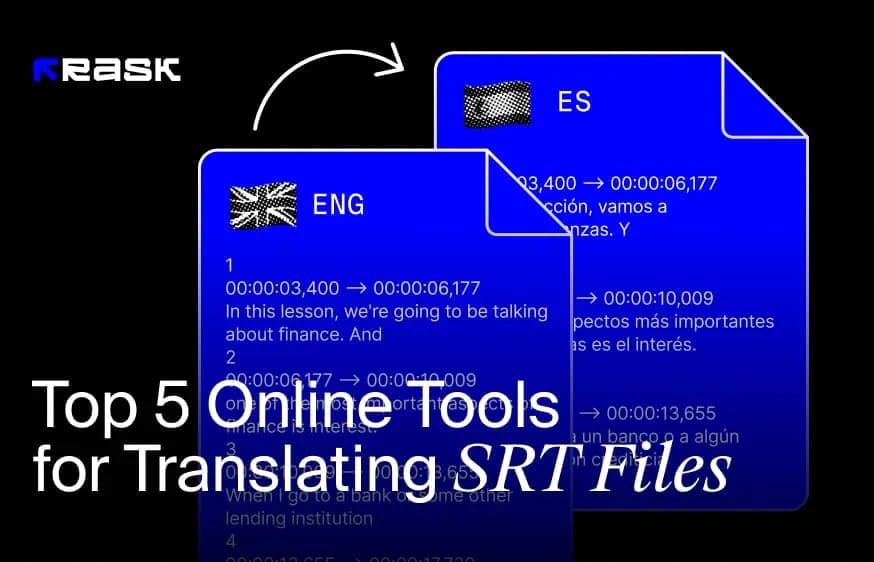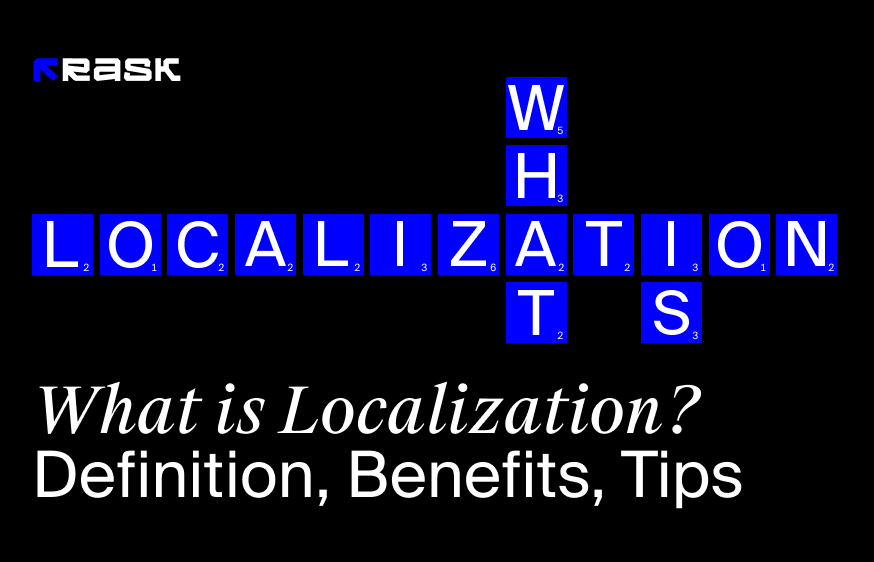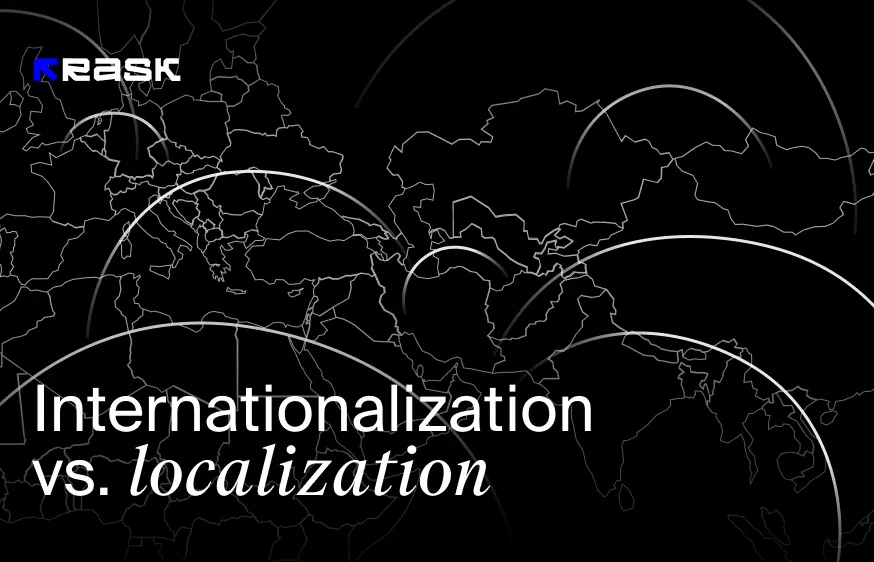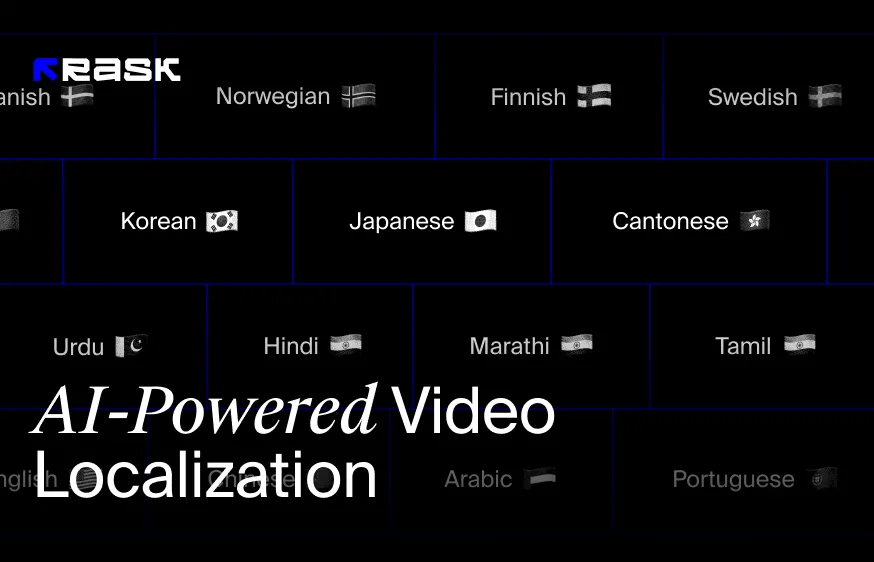Mendorong Penjualan Global: Peran Penting Pelokalan E-commerce
Apa yang ada di dalamnya
Satu hal yang hebat tentang bisnis E-commerce adalah Anda dapat menjual produk Anda ke pasar global. Terlepas dari seberapa jauh pasar baru dari kantor pusat utama Anda, pelokalan E-commerce masih dapat direalisasikan.
Meskipun perangkat lunak pelokalan membuat prosesnya lebih mudah dan lebih cepat, prosesnya tidak sesederhana kelihatannya. Pelanggan internasional biasanya jatuh pada rintangan pertama. Jika situs web Anda bersifat umum dengan harga lokal dan salinan situs web yang hanya tersedia dalam bahasa Inggris - peluang Anda untuk sukses cukup rendah. Mengapa?
Personalisasi. Ya, personalisasi adalah hal yang mendorong penjualan internasional dalam hal pelokalan dan toko E-commerce. Kebanyakan orang lebih suka melihat situs web e-commerce dengan konten yang tersedia dalam bahasa asli mereka, dengan harga yang relevan dalam mata uang yang dibutuhkan, dan situs web yang mencakup nuansa budaya.
Itulah yang dimaksud dengan pelokalan. Anda ingin membuat situs web sepersonal mungkin, sehingga mencakup semua perbedaan yang mungkin dimiliki oleh target audiens baru Anda. Dan dalam panduan ini, Anda akan belajar bagaimana mengatur prosesnya agar tidak terasa begitu berat dan mahal.
Mari Kita Mulai dengan Apa itu Pelokalan E-commerce?
Pelokalan e-commerce adalah proses mengambil konten toko online dan mengadaptasinya ke pasar yang berbeda.
Katakanlah Anda memiliki situs web e-commerce yang menjual produk hanya untuk pelanggan target Inggris. Sekarang Anda ingin mengirimkan produk ke Amerika Serikat dan Spanyol. Meskipun Anda bisa memberikan opsi baru dalam hal pengiriman, pelokalan akan menghasilkan penjualan x5 kali lipat.
Akibatnya, Anda perlu menyesuaikan toko Anda dengan pasar Spanyol dan Amerika. Hal ini termasuk menerjemahkan konten ke berbagai dialek dan bahasa, menerapkan mata uang baru, dan membuat keseluruhan situs web yang sesuai untuk pengunjung baru.
Mengapa Pelokalan E-commerce Penting?
Seperti yang kami katakan, Anda bisa saja mengatakan bahwa sekarang Anda berbelanja di pasar yang baru. Namun dalam 99% kasus, hal ini tidak akan mengubah citra Anda dan, oleh karena itu, tidak akan meningkatkan penjualan. Bagaimana pelanggan baru Anda tahu apa yang Anda kirimkan ke pasar baru? Bagaimana mereka akan memahami mata uang dan bahasa lokal Anda? Dan jika mereka menangani kedua pertanyaan ini, mereka masih menginginkan personalisasi, sehingga kemungkinan mereka meninggalkan situs web e-commerce Anda tinggi.
Jadi, mengapa pelokalan Ecommerce sangat penting?
Kalahkan Persaingan
Berdasarkan studi yang dilakukan oleh CSA Research, 75% pelanggan ingin menggunakan situs web dalam bahasa asli mereka. Sumber yang sama melaporkan bahwa 92,2% pelanggan potensial ingin melakukan pembelian dalam mata uang mereka sendiri.
Jadi, jika Anda ingin mengglobalkan bisnis Anda dan membuka aliran pendapatan baru, pelokalan E-commerce harus dimiliki. Statistik dari studi yang kami berikan di atas juga menunjukkan bahwa pelanggan mendukung merek yang memenuhi kebutuhan mereka. Jika tidak berinvestasi dalam pelokalan E-commerce, Anda akan kalah bersaing dengan pesaing lokal.
Menjangkau Pasar yang Lebih Luas
Pendapatan AS dari situs web E-commerce pada tahun 2017 adalah $449,88 miliar. Bandingkan dengan pendapatan China pada tahun yang sama - $877,00 miliar untuk tahun yang sama. Anda tidak akan terkejut mengetahui bahwa memperluas toko Anda ke pasar internasional memiliki banyak manfaat. Tetapi hal ini juga membutuhkan penggunaan strategi pelokalan Ecommerce yang tepat untuk mencapai hasil.
7 Manfaat Pelokalan E-commerce
Meningkatkan Loyalitas Pelanggan
Pembeli online menyukai situs E-commerce global yang dibuat dalam bahasa asli mereka. Mempersonalisasi konten dan pengalaman pelanggan secara keseluruhan menunjukkan kepada pelanggan bahwa Anda peduli. Hal ini, pada gilirannya, menumbuhkan loyalitas pelanggan.
Meningkatkan Pangsa Pasar dan Pendapatan
Pelokalan e-commerce berarti menyesuaikan bahasa, konten, elemen UI, dan produk dengan target audiens tertentu. Hal ini memungkinkan merek Anda menjalin hubungan yang kuat dengan pelanggan internasional. Dengan menghadirkan produk Anda ke pasar internasional juga berarti Anda meningkatkan pendapatan.
Skala Perusahaan
Anda mungkin tahu bahwa toko E-commerce tradisional membutuhkan waktu bertahun-tahun untuk meningkatkan skala dan berkembang di pasar yang baru. Tetapi pelokalan memungkinkan kita untuk mencapai hal ini dalam hitungan bulan. Mari kita ambil contoh Mensa, sebuah perusahaan rintisan D2C dari India. Perusahaan ini mampu mencapai status unicorn hanya dalam waktu enam bulan tahun lalu berkat pelokalan E-commerce.
Manfaatkan Peluang Spesifik Wilayah
Di mana pun lokasi merek Anda, Anda dapat mulai menuai manfaat dari peluang liburan lokal. Misalnya, jika Anda menjalankan toko E-commerce di AS dan memutuskan untuk melokalkan toko Anda di Spanyol, Anda akan dapat membuat kampanye musiman dan menguntungkan untuk hari liburnya yang populer.
Mengurangi Siklus Pembelian Konsumen
Jika pelanggan potensial Anda mencari produk tertentu dan menemukan situs Anda yang dilokalkan, kemungkinan mereka membeli dari Anda cukup tinggi. Kurangnya perbedaan bahasa dan budaya mengurangi gesekan yang mungkin muncul dalam prosesnya, sehingga mempercepat siklus pembelian.
Meningkatkan SEO
SEO multibahasa (juga dikenal sebagai pengoptimalan mesin pencari) adalah elemen penting untuk meningkatkan keberadaan pencarian setelah Anda melokalkan toko E-commerce Anda. Pelokalan menjamin bahwa klien potensial akan dapat menemukan toko Anda menggunakan pencarian organik, memasukkan frasa pencarian dalam bahasa asli mereka. Dengan demikian, Anda juga akan memiliki posisi yang lebih tinggi di mesin pencari yang relevan.
Data Perilaku Konsumen
Pelokalan toko e-commerce mendatangkan lebih banyak klien potensial dari wilayah target Anda. Proses ini memungkinkan Anda mengumpulkan sejumlah besar data spesifik wilayah, termasuk pola pembelian, demografi, dan preferensi pembelian. Dengan menggunakan data ini, Anda dapat mengambil keputusan berdasarkan data, yang akan membantu Anda menarik lebih banyak pembeli online.
Elemen Pelokalan E-commerce yang Berhasil untuk Audiens Target Baru
Pelajari Preferensi Audiens Target
Setiap wilayah memiliki lanskap E-commerce dan kebutuhan konsumennya sendiri. Lokasi mengacu pada pengaturan parameter yang menentukan bahasa, negara, dan preferensi spesifik pengguna. Itulah mengapa penting untuk tetap menyadari nuansa apa pun yang mungkin dimiliki oleh audiens target baru Anda sehingga Anda dapat menyesuaikan belanja online E-commerce Anda.
Pertanyaan-pertanyaan berikut ini mungkin dapat membantu:
- Metode pembayaran apa yang populer?
- Apakah klien potensial baru Anda memiliki akses ke opsi pengiriman dan logistik yang cepat?
- Apa saja peraturan yang ada dalam industri E-commerce di daerah tersebut?
Lakukan Audit UX
Kemudahan penggunaan dan keakraban situs web bukanlah fitur yang universal. Itulah mengapa Anda harus memastikan Anda mengembangkan desain yang relevan untuk pasar lokal, termasuk citra, skema warna, perjalanan pengguna, dan semua elemen UX lain dari toko E-niaga Anda.
Pelokalan UX Ecommerce memainkan peran yang sama dengan penerjemahan konten dalam proses E-commerce. Hal ini memungkinkan merek Anda memberikan pengalaman pelanggan e-commerce yang luar biasa. Perbedaan budaya yang tercakup, norma-norma regional, ekspektasi pengguna, dan bahasa adalah beberapa faktor utama yang pada akhirnya akan memengaruhi cara calon pelanggan Anda memandang merek dan produk Anda. Melokalkan UX yang sesuai akan membantu mencapai tujuan yang dibutuhkan.
Pelokalan Harga
Meskipun Anda mengetahui perkiraan harga lokal Anda, produk yang sama dapat berharga lebih mahal atau lebih murah di negara lain - dan itu adalah sesuatu yang harus Anda pertimbangkan agar pelokalan E-commerce berhasil.
Apakah Anda hanya mengonversi harga dari satu mata uang ke mata uang lainnya atau menyesuaikan harga sesuai dengan lokasi baru dan gaji mereka, pastikan Anda mempertimbangkan faktor-faktor seperti pajak, biaya pengiriman, dan lainnya. Harga Anda harus kompetitif di setiap pasar lokal.
Informasi yang Relevan Secara Lokal
Pelanggan e-commerce selalu berharap untuk menemukan informasi yang relevan dengan pasar mereka. Misalnya, terkait spesifikasi produk, ketersediaan di negara mereka, dan ulasan.
Jika Anda memiliki produk spesifik yang hanya tersedia di satu pasar, Anda harus memberi tahu pengguna internet atau tidak menempatkan produk ini di situs E-commerce di area tersebut.
Dukungan Pelanggan Multibahasa
Tingkat dukungan E-commerce sangat penting. Dan ini menjadi lebih penting lagi ketika kita berbicara tentang menempatkan toko Anda di negara lain - bagaimana calon klien Anda akan menyelesaikan masalah yang mungkin mereka hadapi? Apakah Anda menawarkan dukungan dalam bahasa mereka sendiri?
Meskipun Anda bisa menggunakan ChatGPT atau jenis bot lain yang akan bertanggung jawab atas dukungan, mampu berbicara dengan orang sungguhan dan memahami bahasa yang sama membuat pelanggan merasa lebih aman dan menumbuhkan loyalitas mereka.
Pemasaran yang Disesuaikan dengan Lokasi
Anda tidak bisa melokalkan situs Ecommerce tetapi melupakan pemasaran. Setiap negara memiliki kampanye pemasaran yang paling berhasil berdasarkan preferensi pembelian pelanggan. Itulah sebabnya semua materi promosi Anda harus sesuai dengan budaya, bahasa, serta ekspektasi teknologi dari target pasar yang baru.
Menumbuhkan Kepercayaan di Tingkat Lokal
Saat mencoba mengalahkan pesaing, Anda perlu menumbuhkan kepercayaan di pasar yang baru. Pelanggan lokal sering menganggap bisnis online baru yang masuk ke negara tersebut membingungkan dan juga mengejutkan. Cara terbaik adalah masuk dalam kategori kedua sehingga pelanggan Ecommerce berpikir bahwa produk Anda layak untuk dicoba. Tapi itu juga tidak cukup.
Sangat penting bagi Anda untuk bermitra dengan influencer atau berkolaborasi dengan asosiasi industri, sehingga merek Anda dapat muncul di acara-acara atau akun media sosial untuk membangun kepercayaan.
Keterlibatan Pelanggan
Menjual produk saja tidak selalu cukup. Itulah mengapa Anda harus selalu memastikan bahwa Anda terus muncul di kotak masuk atau akun media sosial pelanggan Anda sehingga Anda dapat mengoptimalkan pengalaman pelanggan pasca pembelian. Mengikuti nada yang tepat dan sesuai dengan budaya akan membantu Anda meningkatkan tingkat retensi dan menunjukkan bahwa Anda peduli dengan kepuasan mereka.
Menyesuaikan Penjualan dengan Dinamika Lokal
Sebagai pemilik bisnis E-commerce, Anda mungkin tahu bahwa saluran penjualan dapat sangat bervariasi di berbagai negara dan pasar global. Misalnya, di Argentina, pelanggan paling sering membeli produk melalui aplikasi Facebook dan WhatsApp. Itulah mengapa sangat penting bagi Anda untuk menawarkan saluran penjualan yang relevan agar tidak membingungkan calon pelanggan Anda dan mengubah mereka menjadi klien dengan lebih cepat dan mudah. Ini akan membantu Anda mencapai penjualan E-niaga global yang tinggi.
Praktik Terbaik Pelokalan E-commerce untuk Pasar Sasaran
Mengetahui elemen-elemen pelokalan E-commerce memang bagus. Namun, yang terbaik adalah mengikuti rekomendasi yang telah terbukti dan beberapa praktik terbaik di lapangan yang dapat membantu Anda berhasil.
Melakukan Riset Pasar
Anda harus selalu memulai proses pelokalan dengan riset pasar. Hal ini melibatkan hal-hal berikut:
- Apa bahasa target yang digunakan oleh target pasar yang baru?
- Pola pembelian dan gaji mereka?
- Pesaing saat ini?
- Apa yang dimiliki pesaing yang tidak Anda miliki?
- Kesalahan apa saja yang dilakukan pesaing yang dapat Anda hindari?
- Poin cat utama dari audiens baru Anda?
- Bagaimana produk Anda dapat mengatasinya?
- Hari libur apa saja yang dimiliki oleh lokasi baru ini?
Memprioritaskan Konten Sesuai dengan Tujuan Bisnis
Saat Anda merencanakan strategi pelokalan, kami sarankan Anda menggunakan pendekatan strategis. Ini berarti berfokus pada konten yang telah terbukti menghasilkan ROI paling besar untuk investasi e-commerce Anda.
Ini mungkin termasuk deskripsi produk dengan visibilitas tinggi, kampanye pemasaran email, serta konten blog yang berpotensi mendapat peringkat tinggi di mesin pencari seperti Google. Anda juga bisa menggunakan ChatGPT atau alat lain untuk menghasilkan konten yang tidak terlalu viral - memutuskan apa yang paling cocok untuk bisnis online Anda saat menjelajahi hasilnya.
Berinvestasi dalam SEO Multibahasa
Seperti yang telah kami sebutkan, memiliki toko yang menarik dengan harga terbaik tidak akan ada artinya jika calon klien tidak dapat menemukan situs dalam bahasa asli mereka. Itulah mengapa Anda harus menjamin bahwa Anda dapat menjangkau sebanyak mungkin calon pelanggan, dengan berinvestasi dalam SEO multibahasa.
Lokalisasi Keranjang Belanja
Anda juga harus memastikan halaman checkout dan keranjang menarik dengan mudah dan dapat dimengerti oleh pelanggan internasional. Itulah mengapa Anda harus melokalkannya dan menampilkan mata uang yang relevan. Jangan lupa untuk menerapkan metode pembayaran yang populer secara lokal, serta tarif pengiriman dan pajak yang relevan sesuai dengan wilayah masing-masing pelanggan.
Format Tanggal dan Waktu
Bahkan toko E-commerce yang paling berpengalaman pun bisa melupakan format tanggal dan waktu. Tetapi standar ini sangat masuk akal bagi pelanggan internasional. Misalnya, tanggal mendahului mulut ketika Anda menulis tanggal di sebagian besar negara Eropa. Ini terlihat seperti ini: "4 Agustus," sedangkan "4 Agustus" adalah cara penulisan tanggal di AS dan Kanada.
Mematuhi Peraturan Daerah
Salah satu masalah utama yang mungkin Anda hadapi dalam pelokalan adalah tetap mematuhi peraturan dan hukum yang berbeda di setiap negara. Apa saja aturan perlindungan data lokal? Apakah Anda diwajibkan untuk memungut pajak? Jika ya, berapa tarif untuk wilayah tertentu ini? Berapa biaya pengiriman yang diperbolehkan untuk mereka?
Meskipun hal ini harus dieksplorasi pada tahap pertama pelokalan (penelitian), Anda selalu dapat menginvestasikan lebih banyak waktu untuk mengeksplorasi peraturan karena hal ini dapat memperlancar proses atau merusak reputasi online Anda jika dilakukan dengan cara yang salah.
Menyediakan Dukungan Pelanggan yang Relevan dengan Waktu
Kita telah membahas pentingnya menyediakan dukungan pelanggan dalam bahasa lokal audiens target. Tetapi poin ini lebih dari itu: Anda juga perlu mempertimbangkan berbagai faktor dukungan yang relevan dengan waktu. Ini termasuk perbedaan zona waktu, periode yang lebih sibuk, serta hari libur lokal. Menyesuaikan dukungan pelanggan Anda menunjukkan kepada pengguna E-niaga internasional bahwa Anda mengetahui negara dan aturan mereka dan bahwa Anda peduli - mempersonalisasi pengalaman pelanggan.
Jangan Lupakan Media Sosial
Kita hidup di dunia di mana media sosial memainkan peran besar dalam kehidupan masyarakat modern. Jadi tidak mengherankan jika pelokalan juga melibatkan postingan media sosial. Namun, yang terbaik adalah memilih platform media sosial yang populer di tempat tertentu, sehingga Anda tidak ingin membuang-buang uang untuk platform yang bahkan tidak digunakan di negara tertentu.
Bagaimana Cara Melokalkan Toko E-commerce Anda untuk Pelanggan Internasional?
Langkah 1: Menerjemahkan situs web e-commerce Anda
Oke, akhirnya kita sampai di sini. Langkah pertama yang harus dilakukan dalam proses pelokalan adalah menerjemahkan konten situs web Ecommerce Anda. Meskipun Anda selalu dapat menyewa spesialis penerjemahan dan menggunakan layanan pelokalan, cara termudah dan tercepat untuk mendapatkan hasil terbaik adalah dengan menggunakan perangkat lunak penerjemahan. Dalam hal penerjemahan konten video, Anda selalu dapat menggunakan Rask AI, yang didukung oleh AI yang menawarkan terjemahan akurat ke dalam lebih dari 130 bahasa.
Saat Anda perlu menerjemahkan konten teks, kami sarankan untuk mencari layanan pelokalan dengan pengalaman belanja online yang relevan di bidang Anda atau perangkat lunak yang menggunakan penerjemahan mesin saraf tingkat lanjut. Teknologi ini menggunakan algoritme canggih yang "belajar" tentang bahasa baru dan menerjemahkannya, yang berarti teknologi ini terus mempelajari cara yang paling alami dan akurat untuk menerjemahkan konten.
Langkah 2: Lokalisasi Pengalaman Checkout Anda
Melokalkan kasir dan kartu sama pentingnya dengan penerjemahan toko. Checkout adalah halaman terakhir yang dapat membawa bisnis E-commerce menuju kesuksesan atau membuat pelanggan meninggalkan toko Anda dan tidak akan pernah kembali lagi. Pilihan kedua terjadi ketika Anda tidak memiliki situs web yang sepenuhnya dilokalkan dan pengalaman checkout.
Hal ini terjadi karena mereka tidak mengerti apa yang harus dilakukan agar produk mereka sampai ke rumah mereka. Mereka mungkin juga merasa bingung, tetapi halaman checkout harus dibuat semulus mungkin.
Formulir Pelokalan Bidang
Bidang formulir bervariasi dari satu negara ke negara lain. Dan membuat formulir alamat ini dengan benar akan membantu Anda mencapai hasil terbaik dengan upaya pelokalan Ecommerce Anda.
Katakanlah Anda menjalankan toko E-niaga yang berbasis di AS dan ingin berekspansi ke pasar Inggris. Di situlah Anda perlu menyediakan formulir yang dapat diisi oleh penduduk Inggris. Nomor telepon di AS memiliki format sebagai berikut: xxx-xxx-xxxx. Format telepon di Inggris adalah xxx-xxxx-xxxx.
Selain itu, setiap negara menangani alamatnya secara berbeda. Mari kita jelajahi satu contoh saja - di Jepang, jalan tidak memiliki nama karena kota diatur dalam beberapa blok. Sebagian besar situs E-niaga terkemuka akan secara otomatis mengganti formulir alamat pada saat pembayaran sehingga sesuai dengan negara tertentu.
Langkah 3: Melokalkan Citra Merek dan Materi Pemasaran
Langkah terakhir adalah memastikan citra merek E-commerce Anda dan materi pemasaran disesuaikan secara khusus dengan audiens Anda dan apa yang mereka sukai. Ini akan membantu Anda mengatur pesan merek yang tepat untuk berbagai platform.
Misalnya, beberapa negara lebih menyukai konten video, jadi Anda perlu menggunakan alat bantu AI seperti Rask AI untuk pembuatan konten video dalam bahasa lokal.
Ada beberapa hal yang perlu difokuskan di sini:
Visual: Toko E-commerce terkemuka sangat bergantung pada visual yang berkualitas. Tetap netral tidak akan membawa kesuksesan bagi merek Anda. Meskipun tidak akan menyebabkan kesalahan besar yang merusak bisnis Anda, masih ada baiknya memeriksa apakah gambar yang Anda pilih relevan dengan wilayah yang berbeda.
Tren penjualan dan hari libur: Seperti yang kami sebutkan di atas, hari libur nasional bisa menjadi peluang besar bagi Anda. Namun, hari libur nasional di setiap negara berbeda-beda. Jadi, saat Anda membuat materi promosi dan kampanye, pastikan semuanya tetap relevan dengan pasar lokal dan hari libur spesifik mereka sehingga Anda membuka aliran pendapatan hari libur lokal yang baru.
Nilai: Mempelajari nilai dari target pasar baru Anda akan membutuhkan waktu. Namun, ketika kita melihat tren dalam domain lokal E-commerce, orang-orang cenderung fokus dan mendukung merek yang menawarkan produk dan opsi pengiriman yang berkelanjutan dan ekologis. Itulah mengapa Anda harus mempertimbangkan bagaimana Anda akan memberikan nilai ini kepada audiens Anda.
Penutup | Pelokalan
Melokalkan toko eCommerce sekarang menjadi lebih penting dari sebelumnya. Kita hidup di dunia yang sangat digital di mana orang memiliki banyak pilihan untuk dipilih, jadi menonjolkan merek Anda adalah suatu keharusan. Di situlah pelokalan menjadi penting.
Meskipun dapat dipercepat dengan perangkat lunak seperti Rask AI, proses ini masih merupakan proses yang luas dan berkelanjutan yang melibatkan wawasan yang komprehensif tentang pasar luar negeri, nuansa budaya, dan teknologi canggih.
PERTANYAAN YANG SERING DIAJUKAN
Pelokalan e-commerce mengacu pada proses mengadaptasi toko ke lokasi baru untuk ekspansi bisnis internasional. Proses ini melibatkan beberapa bagian, termasuk penerjemahan konten, pengoptimalan kampanye pemasaran, menawarkan metode pembayaran yang relevan, menerjemahkan deskripsi produk, dan adaptasi elemen UX.
Pelokalan e-commerce kini menjadi hal yang wajib dimiliki oleh setiap toko e-commerce yang mencari target pasar baru. Ini adalah elemen kunci dalam memberikan pengalaman e-commerce yang luar biasa karena mencakup semua bagian adaptasi situs ke lokasi baru.
Pelokalan dalam bisnis berarti membuat produk/layanan Anda tersedia di negara-negara baru. Berbeda dengan hanya memperluas opsi pengiriman, pelokalan membuat produk/layanan menjadi akrab bagi audiens target baru dengan menerjemahkan dan mengadaptasi seluruh situs web E-niaga dan kampanye pemasaran.






.jpg)
.webp)




![8 Aplikasi Penerjemah Video Terbaik untuk Pembuat Konten [dari 2024]](https://rask.ai/cdn-cgi/image/width=960,format=auto,fit=scale-down/https://cdn.prod.website-files.com/63d41bc99674c403e4a7cef7/6668a3dcd3175bd1d1c73c81_Best%20video%20translator%20apps%20cover.webp)
![Perangkat Lunak Sulih Suara AI Terbaik untuk Pelokalan Video [tahun 2024]](https://rask.ai/cdn-cgi/image/width=960,format=auto,fit=scale-down/https://cdn.prod.website-files.com/63d41bc99674c403e4a7cef7/66685014f68137eb05c89c16_Cover.webp)





.webp)














